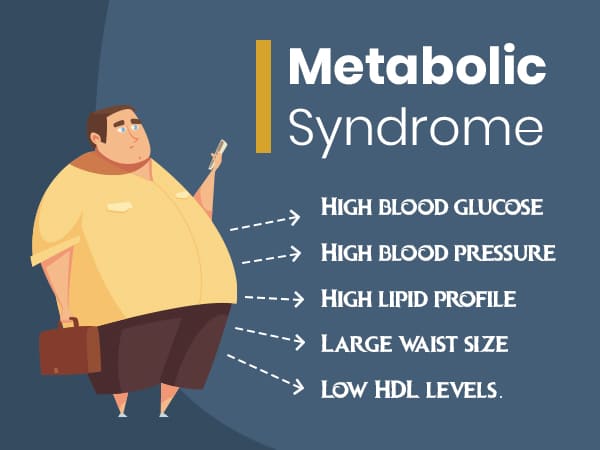Dear Friend,
After covering Osteoporosis/Osteopenia, in my last blog post I am discussing today an even more widespread health issue, the Metabolic Syndrome. Roughly 1/3 of the US adult population is affected by Metabolic Syndrome and thereby living with a heightened risk for Heart Disease, Stroke, and Diabetes Type 2.
What is Metabolic Syndrome?
Metabolic Syndrome is a collection of different conditions that combined are defined as Metabolic Syndrome. These conditions are:
- Elevated Blood Glucose Levels
- A large Waistline often associated with Peripheral Insulin Resistance
- Elevated Triglyceride Levels
- Low HDL Levels (High Density Lipoprotein – Good Cholesterol)
- Hypertension (high blood pressure)
Sedentary Lifestyle (my own addition)
Living with only one of these conditions doesn’t qualify you for a diagnosis of Metabolic Syndrome but with each additional condition your risk for serious disease will increase and if 3 of the top 5 apply to you, you are being diagnosed with Metabolic Syndrome. I added “Sedentary Lifestyle” as it is commonly associated with and a cause of the first 5 conditions mentioned.
What are the causes and risk factors of Metabolic Syndrome?
Metabolic Syndrome is closely connected to being overweight, obese and/or physically inactive. The risk factors, some of which you can’t influence and some that you can address are:
- Age – Risk increases as we grow older
- Ethnicity – Hispanic Americans, especially females and South Asians are seemingly at the highest risk for developing Metabolic Syndrome. The exact reasons remain unknown.
- Family History
- Obesity – Extra weight, especially in the mid section (apple shape) is associated with a heightened risk for Metabolic Syndrome,
- Other Medical Conditions that increase the risk for developing Metabolic Syndrome are Polycystic Ovary Syndrome, Non-Alcoholic Fatty Liver, Cholesterol Gallstones.
Symptoms and Diagnosis
None of the above-mentioned conditions really show any noticeable symptoms. The only one easy to detect is the large waistline. You typically don’t feel high blood pressure or high Cholesterol/Triglycerides. So, the only way to detect and diagnose Metabolic Syndrome is via various tests ordered by your doctor.
How can I prevent and treat Metabolic Syndrome?
The most successful way to prevent Metabolic Syndrome is also part of the treatment plan once diagnosed with Metabolic Syndrome. Lifestyle Modifications are a great way to avoid and treat Metabolic Syndrome. Lifestyle changes do most commonly refer to dietary changes and the integration of physical activity into daily life, while reducing or eliminating tobacco and alcohol consumption. Once diagnosed with Metabolic Syndrome pharmacological intervention in addition to the previously mentioned lifestyle modifications can help inhibit the development of Diabetes Type 2.
Diet
Several studies have found that diets high in fresh fruits and vegetables are a successful strategy in preventing Metabolic Syndrome. The exact correlation isn’t fully understood. Often diets rich in fruits and vegetables make it easier to maintain a healthy weight, which is one condition increasing the risk for Metabolic Syndrome. However even amongst adults that were able to maintain a healthy BMI (Body Mass Index) fruit and vegetable consumption, or a lack thereof was found to be an independent predictor of incidence for Metabolic Syndrome. Two European studies found that folks adhering to the Mediterranean Diet (rich in fruits and vegetables) showed a significantly reduced prevalence and incidence rate for Metabolic Syndrome. In summation, dietary changes should not only aim at weight reduction but include an increase in fruit and vegetable consumption. (Lifestyle changes and prevention of metabolic syndrome in the Heart of New Ulm Project, NIH 6/2017). Besides increasing your fruit and vegetable intake most health care providers suggest wholesome grains and lean protein to help with the waistline.
Physical Activity/Exercise
Regular or daily exercising has shown to reduce the prevalence and incidence of Metabolic Syndrome. Exercising can help reduce body weight, reduce blood pressure, improve blood lipid levels including raising HDL and lowering Triglycerides, as well as improving peripheral insulin resistance and glucose tolerance.
The recommendations for Exercising aren’t different from those for healthy adults. Engage in structured exercising for 30-60 minutes at least on 5 days per week, daily if you have already been diagnosed with Metabolic Syndrome or are overweight. Moderate intensity aerobic cardiovascular activities such as brisk walking, jogging, swimming, and cycling are the most recommended forms of exercise in the medical literature I studied. I would suggest adding strength and resistance training to your favorite type of aerobic cardiovascular activity to increase your metabolism, reduce your body weight and be more successful in keeping it off! No matter what exercise program you chose to follow, be realistic about goal setting and make sure it’s a form of physical training that you enjoy or at the very least easily tolerate. An exercise program, no matter how well designed is only working if it’s being followed. Compliance depends a great deal on joy, ease of access and small successes.
Alcohol and Tobacco
Light to moderate alcohol consumption has been promoted in many studies as healthy and possibly life prolonging while excessive alcohol consumption is associated with a heightened risk for obesity, high Triglyceride levels, Hypertension, and possibly increased Insulin Resistance, all major contributing factors to Metabolic Syndrome. To prevent or treat Metabolic Syndrome it is recommended to limit yourself to light drinking. While wine shows a greater protective quality than beer, liquor is increasing the risk for Metabolic Syndrome.
Smoking increases the risk for Metabolic Syndrome by several mechanisms. Nicotine increases the output of several neurotransmitters and hormones associated with elevated blood pressure. In addition, we find increased levels of inflammatory biomarkers such as C-reactive Protein. Smokers commonly present with higher Triglyceride levels and lower HDL levels than non-smokers. If you are as smoker and are trying to prevent or treat Metabolic Syndrome, please consider smoke cessation.
Pharmacological Intervention
Medications to treat Metabolic Syndrome typically address the various metabolic risk factors, by lowering Cholesterol, Blood Pressure, Blood Glucose, and increase Insulin Sensitivity. Please discuss the details of the medical treatment with your physician.
I hope that today’s blog post has given you a better understanding what Metabolic Syndrome is and how you can prevent and treat it. As always if you have questions or are interested in exploring a personalized Fitness Training Program to address the Prevention/Treatment of Metabolic Syndrome please contact me via email or leave a comment!
In good health.
Hartmut Broring, M.S. Physio-Therapy

